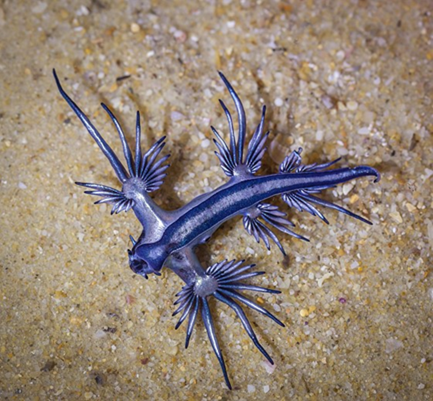
The term ‘sea slug’ may not create excitement in the minds of some, but these colourful creatures are definitely something to marvel at. Nudibranchs are gastropod molluscs that lack a shell and can be found in many marine habitats around the world, including the South Australian coastline. There are known to be around 3000 species of nudibranch (Vincent 2011), all with their own unique colours and defence mechanisms. The name nudibranch translates to “naked-gills” because many species of nudibranch have a cluster of gills on their dorsal surface used for respiration, whereas others use tentacle-like outgrowths called cerata that cover their whole dorsal surface (Smithsonian Ocean n.d.).
Evolution of Colouration and Defence
Due to their lack of shell, nudibranchs have evolved many ways to deter predators, creating an enormous array of diversity. Species of chromodorid nudibranchs display many beautiful colour patterns used as aposematism, to warn their predators that they are toxic. Many chromodorids also use Mullerian mimicry, where two unrelated species have evolved to have similar colour patterns to signal their toxicity, in which their predators learn to avoid both species. Chromodorids gain their toxicity by feeding on sponges and redirecting the chemicals found in those sponges into their own tissues, creating a foul taste for those game enough to attack (Rudman 1991).
 Image: Chromodoris willani (Kuang Loh 2021)
Image: Chromodoris willani (Kuang Loh 2021)
Aeolid nudibranchs have a similar process, where they feed on cnidarians, such as sea anemones and Portuguese Man O’ War, and ingest their nematocysts. Nematocysts are minuscule capsules that contain a tightly wound thread and barb, that when exposed to a predator will shoot into their tissue and release venom. The nematocysts that are ingested by the nudibranch are transported through its digestive system and into sacs, called cnidosacs, that are located at the tips of their cerata (Greenwood & Mariscal 1984). Glaucus atlanticus is one species that is well known for this type of defence, often found floating in tropical and subtropical waters showcasing its beautiful blue colouring.
 Image: Glaucus atlanticus (Kippax 2019)
Image: Glaucus atlanticus (Kippax 2019)
Other families like the dorids have dull colouring and textures that camouflage with the sponges they live and feed on. There are even sea slugs closely related to nudibranchs that can utilise chloroplasts from the algae they feed on. They are known as sacoglossans and use the ingested chloroplasts for photosynthesis, generating an extra supply of energy (Vincent 2011). They are effectively solar-powered slugs!
 Image: Hopkin’s rose nudibranch (Pomeroy 2014)
Image: Hopkin’s rose nudibranch (Pomeroy 2014)
Indicators of Climate Change
Not only are these amazing creatures’ evolutionary geniuses, but they are also very important in tracking the impacts of climate change. Nudibranchs only have a short life span of less than a year, meaning they can be severely impacted by changes in environmental conditions, like those seen due to climate change. The Sea Slug census that is run annually along the eastern coast of Australia is used to determine whether distributions of nudibranch species have changed, as well as identify new species. Professor Steve Smith, who is involved with the census, suggested that many species are already being found further south than recently observed. This could be due to southern waters increasing in temperature, making it more favourable for tropical species, as well as an increased strength of the East Australian Current caused by climate change. The EAC may be transporting larval stages of nudibranchs further south than normal (Siossian & Marshall 2021).
Scientists in California have also found Hopkin’s rose nudibranchs, that normally inhabit southern Californian waters, are migrating north. Although not detrimental to the northern Californian coastal environment, it provides evidence for a warming climate (Landhuis 2015).
With such a high importance in climate change research, combined with their spectacular adaptations, nudibranchs are certainly not your typical slug.
Article written by Tamika Heath
References
Greenwood, P & Mariscal, R 1984, ‘The utilization of cnidarian nematocysts by aeolid nudibranchs: Nematocyst maintenance and release in spurilla’, Tissue and Cell, vol. 16, no. 5, pp. 719-730.
Kippax, C 2019, Glaucus atlanticus, viewed 27 August, https://www.dpreview.com/forums/post/62856433.
Kuang Loh, E 2021, Underwater Photo Gallery: Eu Kuang Loh, viewed 27 August, http://www.divephotoguide.com/user/diverstan/gallery/aug_09/.
Landhuis, E 2015, ‘Bright Pink Sea Slugs Invading New Habitats Due to Global Warming?’, National Geographic, viewed 27 August 2021, https://www.nationalgeographic.com/animals/article/150206-global-warming-sea-slugs-animals-ocean-science-california.
Pomeroy, D 2014, Photo 1048482, viewed 27 August, https://www.inaturalist.org/photos/1048482.
Rudman, W 1991, ‘Purpose in Pattern: The Evolution of Colour in Chromodorid Nudibranchs’, Journal of Molluscan Studies, vol. 57, no. 4, pp. 5-21.
Siossian, E & Marshall, C 2021, ‘Nudibranchs help scientists map climate change at the showy sea slugs' annual census’, ABC News, viewed 27 August 2021, https://www.abc.net.au/news/2021-02-05/spectacular-sea-slugs-help-track-environmental-health/13118478.
Smithsonian Ocean n.d., A Collage of Nudibranch Colors, Smithsonian Ocean, viewed 27 August 2021, https://www.adelaide.edu.au/writingcentre/sites/default/files/docs/harvard-referencing-guide.pdf.
Vincent, K 2011, ‘Color Evolution in Nudibranchs’, KQED, viewed 27 August 2021, https://www.kqed.org/quest/19245/color-evolution-in-nudibranchs.